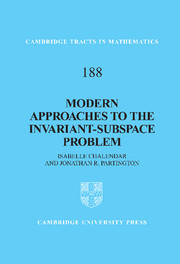Book contents
- Frontmatter
- Contents
- Preface
- 1 Background
- 2 The operator-valued Poisson kernel and its applications
- 3 Properties (An,m) and factorization of integrable functions
- 4 Polynomially bounded operators with rich spectrum
- 5 Beurling algebras
- 6 Applications of a fixed-point theorem
- 7 Minimal vectors
- 8 Universal operators
- 9 Moment sequences and binomial sums
- 10 Positive and strictly-singular operators
- References
- Index
8 - Universal operators
Published online by Cambridge University Press: 07 October 2011
- Frontmatter
- Contents
- Preface
- 1 Background
- 2 The operator-valued Poisson kernel and its applications
- 3 Properties (An,m) and factorization of integrable functions
- 4 Polynomially bounded operators with rich spectrum
- 5 Beurling algebras
- 6 Applications of a fixed-point theorem
- 7 Minimal vectors
- 8 Universal operators
- 9 Moment sequences and binomial sums
- 10 Positive and strictly-singular operators
- References
- Index
Summary
If the invariant-subspace problem in Hilbert spaces has a negative solution, then there must be a counterexample, but at the time of writing nobody has been able to find one. On the other hand, if the solution is positive, then at first sight it is necessary to prove a theorem that applies to all Hilbert space operators simultaneously. In fact, the situation is somewhat simplified by the existence of universal operators – these have the property that if we could describe their lattice of subspaces precisely enough, then we could solve the invariant-subspace problem.
We therefore begin by presenting an old theorem due to Caradus [55] which gives conditions for an operator to be universal. With this, it is easy to write down various very simple operators, basically various forms of backward shift operator, which have the universality property.
Other operators that are less obviously universal include certain bilateral weighted shifts and composition operators on Hardy spaces; these last have attracted particular interest, since one can use results from function theory to obtain information about their invariant subspaces. We give some of the more interesting results in this area, although of course we cannot yet give a precise description of the lattice of invariant subspaces for any single universal operator.
Construction of universal models
Definition 8.1.1 Let χ be a Banach space. Then an operator U ∈ ℒ(χ) is said to be universal for χ if for each non-zero T ∈ ℒ(χ) there is a constant λ ≠ 0 and an invariant subspace M for U such that U|M is similar to λT, i.e., λJT = UJ, where J : X → M is a linear isomorphism.
- Type
- Chapter
- Information
- Modern Approaches to the Invariant-Subspace Problem , pp. 213 - 232Publisher: Cambridge University PressPrint publication year: 2011

